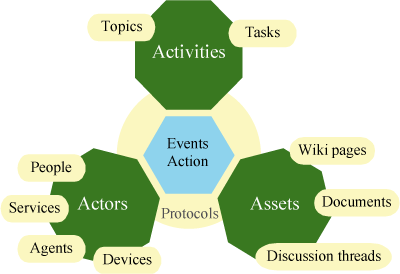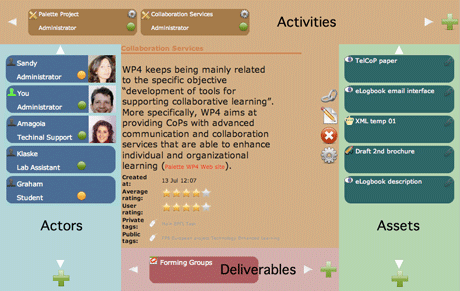by Denis Gillet, Chiu Man Yu and Sandy El Helou
After years of quest by the computer-supported collaborative work community for true user satisfaction, social software and communities of practice turn out to be the enabling frameworks for natural and effective collaborative learning and knowledge management. In the framework of the European Integrated Project PALETTE, the École Polytechnique Fédérale de Lausanne (EPFL) is developing the eLogbook Web 2.0 social software (http://eLogbook.epfl.ch). The purpose of eLogbook is to support tacit and explicit knowledge management in communities of practice (CoPs). It can be customized by users to serve as an asset management system, a task management system or a discussion platform. It will also be deployed as a general-purpose collaborative workspace for project-based learning activities at the EPFL.
Interaction Model
The participatory design approach chosen in PALETTE relies on the full involvement of CoP members and mediators at all the development stages of eLogbook. After a year of implementation, the main result of this process turns out to be the necessity to provide CoPs with mediation solutions that are able to evolve with their interaction modes and practices. As a consequence, eLogbook is built upon the integration of three entities on which users can focus: the Actors, the Activities and the Assets. An actor is any entity capable of initiating an event in the collaborative environment (eg people, Web services, agents or online devices). An asset is any kind of resource (eg multimedia documents, wiki pages or discussion threads) shared between community actors. An activity is the formalization of a common objective to be achieved by a group of actors (topics, tasks). Events or actions related to these three main entities are governed by Protocols. Figure 1 illustrates the eLogbook 3A (Actors, Activities, Assets) interaction model.

The support of asset management distinguishes eLogbook from general one-to-many forms of social software such as blogs and podcasts. eLogbook enables CoPs to store, share and manage their knowledge and practices in the form of assets. The actors of the CoPs can thus perform many-to-many knowledge sharing. CoPs evolve dynamically by adding, updating or removing 3A entities. eLogbook follows the community evolution by maintaining the relationships between the entities. Users can choose to focus on any entities according to their mediation needs. These versatile features contribute significantly to the full appropriation and acceptance of eLogbook as a mediation solution by CoP members.
Context-Sensitive Interface
The main eLogbook view is context-sensitive and maps the 3A model. Its central region displays a focal element chosen by the user: either one of the 3A entities, or a deliverable. The four surrounding regions (left, top, right, bottom) display respectively the actors, activities, assets and deliverables related to the focal element. They also display the relationships between the focal element and these associated entities, and attach the possible related actions that the current user is allowed to perform. Awareness cues of various types are seamlessly incorporated in every region through the use of symbolic icons, colours and display orders of information. For example, deliverables with earlier deadlines are highlighted in red and appear before on the deliverable list than those with later deadlines.

Figure 2 presents an example of the context-sensitive view where a specific activity is chosen as the focal element. The area surrounding this focal element is populated with the associated and complementary entities, contextually related. The view embeds different types of awareness that are important to the users. Entity descriptions can be altered using a Wiki-like editor.
Information Delivery
In addition to Web-based access, eLogbook also supports information delivery through a non-intrusive email-based interface. Thanks to this interface, users can manage their activities, assets and awareness in a ubiquitous way. This alternative lightweight interface first facilitates the appropriation of eLogbook by CoP members. Novice users can in fact share knowledge artefacts and be made aware of ongoing activities through their familiar email client software. Second, it gives easy access to eLogbook with smart phones or PDAs. In the future, eLogbook will support RSS feeds as another means of information delivery for mobile users. The compact format of RSS feeds is particularly useful for mobile users subjected to device constraints. Using authentication, the information of RSS feeds can be personalized for individual users.
Information relevance is of major concern in eLogbook. To avoid excessive interruptions and unnecessary alerts, it is important to dynamically adapt the notification system to the user context, eg device and situation. An adaptive notification filtering system for eLogbook is currently under development.
Links:
http://palette.ercim.org/
http://eLogbook.epfl.ch/
Please contact:
Denis Gillet
École Polytechnique Fédérale de Lausanne (EPFL), Switzerland
E-mail: denis.gillet![]() epfl.ch
epfl.ch










